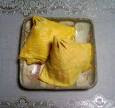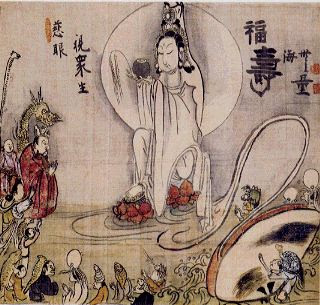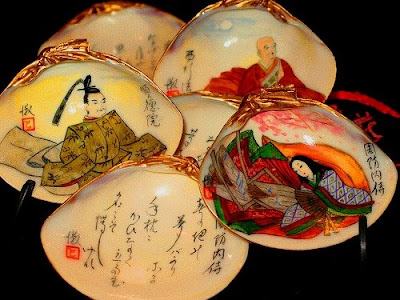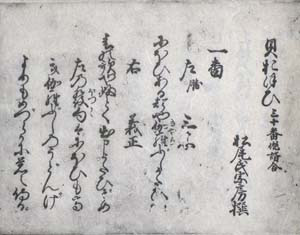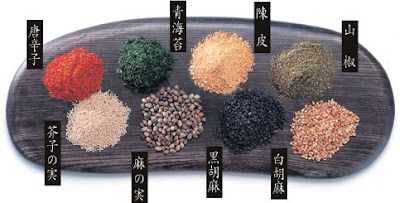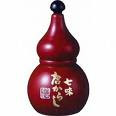[ . BACK to WORLDKIGO TOP . ]
::::::::::::::::::::::::::::::::::::::::::::::::::::::::::::::::::::::::::::::::::::::::::::::::::::
Restaurants
***** Location: Japan
***** Season: Topic
***** Category: Humanity
*****************************
Explanation
There are many types and varieties of restaurants and eateries in Japan, from the highly expensive to the very cheap.
Let us look at some of them, starting from the most expensive ones.
:::::::::::::::::::::::::::::::::::::::::::::::::::::::::::::::::::::::::::::::::::::::::::::::::::
Serving
Kaiseki Ryori 懐石料理, maybe the most expensive, many are located in Kyoto and the other big towns. Often you need a special introduction to go there and NEVER ask for the price of the food!
和食 料理店 Washoku Ryooriten, Restaurants serving only Japanese food. Many have a long tradition and their chefs take great pride in working at a famous place.
食堂 Shokudoo, shokudo, serving Japanese food, often near a station or an area where many people take lunch outside. Some can be quite cheap and are just a large living-room like space in the ground floor of a private home, run by a couple.
taishuu inshokuten 大衆飲食店
restaurant for the masses
often serving cheap Chinese food.
:::::::::::::::::::::::::::::::::::::::::::::::::::::::::::::::::::::::::::::::::::::::::::::::::::::
Specialty Restaurants
Along the many beaches you find the
Amimoto ryoori, 網本料理, food served from fresh catches of the day.
Amimoto is the name for the local boss, who lends boats and equipment to the fishermen.
In the mountains there are still some places specialized on
Matagi ryoori, マタギ料理, the cuisine of the hunters, mostly wild boar and deer.
Curry Rice Shops, karee raisuya カレーライス屋They are specialized for the Japanese version of the Indian Curry. Sometimes it is just a counter with 10 seats, run by a couple.
Soup restaurants, raamenya ラーメン屋Some serve all kinds of soups, some only local ones an area. So you can have your favorite Nagasaki or Sapporo Ramen anywhere in Japan.
. . . CLICK here for Photos !
Sushi Bars, sushiya, 寿司屋
Some are so expensive, you never check the price of any dish and just eat what the master serves you. Often the guests are regular patrons (Stammgast).
Some are food chains and serve any dish for a small amount, like 100 yen or 150 yen. The one's with bands where the dishes roll around the counter, kurukuru sushi くるくる寿司 are of this type. You staple the small dishes at your side and a waiter counts them before writing the bill.
Raw Fish : Sushi, sashimi, sushi and .. rice balls (onigiri)
.................................................................................
ryootei 料亭 first-class Japanese restaurant
Often you need the introduction of a friend to be admitted.

Shinise Ryootei 老舗料亭
Ryotei with a haiku meeting and delicious seasonal food :
Kumiko san 若女将
 source : www.okami-kumiko.com
source : www.okami-kumiko.com
:::::::::::::::::::::::::::::::::::::::::::::::::::::::::::::::::::::::::::::::::::::::::::::::::::::
Family restaurants, ファミリーレストラン, mostly restaurant chains all over Japan, like Denny's.
Many are specialized on "Western Food" yooshoku 洋食, some have a free service of drinks.
. . . CLICK here for Photos !
famiresu ファミレス "family restaurant"
famireus mooningu ファミレスモーニング
family restaurant morning servise
. . . CLICK here for Photos !
The most popular restaurants of this kind are
Aiya 藍屋
Bamian (serving Chinese food) バーミアン
Coco's ココス
Denny's デニーズ
Gusto ガスト
Jonathan ジョナサン
Saizeria サイゼリア
Skylark スカイラーク
Yume-An 夢庵 Washoku
Zensho ゼンショー
After 2010, family restaurants are less popular since families have to tighten the budgets.
:::::::::::::::::::::::::::::::::::::::::::::::::::::::::::::::::::::::::::::::::::::::::::::::::::::
Italian food イタリアン料理 Spaghetti, Pizza, Pasta, Doria, Pesto
. . . . . Jolly Pasta
Fast food chain restaurants ファーストフード, like McDonald, Mister Donuts ミスタードーナツ or Starbucks.
Lotteria to give refunds if customers do not like new hamburger "zetsumyo" for 360 Yen, July 2009.
Lotteria
. . . CLICK here for Photos !
Fast Food Gourmet ... the Japanese Version
Hanbaiki 販売機 vending maschines for food
yooshokuya 洋食屋 restaurants with western food
like omuraisu, katsu cotelettes,
hanbaagu hamburgers,
ebifurai deep-fried shrimp,
hayashi raisu hashee, rizotto rice and many more.
gohan ご飯 in bowls is not served, but
raisu ライス on a plate, to be eaten with the fork.
. . . CLICK here for Photos !
Some have a bit of tradition since the Meiji restauration and opening of Japan and owners in the fourth generation still keep the taste of their great-grandfathers.
The first were around Yokohama when the port opened for foreigners after 1868.
.................................................................................
Many restaurants serve a cheap
daily changing course
higawari ranchi 日替わりランチ
in Kagawa this is called
taimu ranchi タイムランチ / 日替わりタイムランチ
(lunch time, lunchtime is
ranchi taimu ランチタイム).
:::::::::::::::::::::::::::::::::::::::::::::::::::::::::::::::::::::::::::::::::::::::::::::::::::::
Izakaya, 居酒屋, public drinking house, the German KNEIPE, where workers take a sip before going home. Often located close to the station.
Some are chain restaurants, others are just small establishments on the ground floor of a home, run by a couple.
You get a free appetizer (otooshi in Kanto, tsukidashi in Kansai) before ordering.
These are most often also called "Red lampions"
aka choochin、赤提灯, because such an item is hung outside the restaurant.
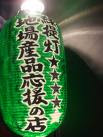
Lately we also have
"Green lampions", midori choochin、緑提灯
They serve healthy food, using naturally grown vegetables, chicken or natural fish from the area only.
The owners are proud to contribute to environmental conservation of resources.
In Kanto, owners are called TENCHO 店長, in Osaka, TAISHOO 大将.
Izakaya in Edo 江戸の居酒屋
 - quote -
- quote -
Izakaya, literally means “stay-in” (i) (liquor shop” (sakaya);
these are much-loved local establishments for casual drinking and dining.
It is said that izakaya were started in the Edo Period (1603-1867) when sake was sold at large in individual servings. People would drink in front of the liquor shops, so eventually the shops began to serve simple foods to go with it. As matter of fact, you can still find some liquor shops that have places to sit and drink with simple finger food today.
- source : japan.stripes.com -
. Food vendors in Edo .
. Toshimaya 豊島屋 first Izakaya in Edo (1596) .
A new type of Izakaya, where all food costs only 270 Yen.
全品270円居酒屋 . 金の蔵Jr.
Open since August 20, 2009. They want to become a nationwide chainstore.
東京都新宿区新宿3-35-18
全品299円居酒屋 金の蔵Jr.
全品300円居酒屋 金の蔵Jr.
. . . CLICK here for Photos !
Check their menu HERE
http://r.gnavi.co.jp/g078868/menu4.htm
Izakaya ... die japanische Kneipe
CHOOCHIN, lanterns and restaurants 提灯とだるま
WKD : Izakaya - The Japanese Pub Cookbook
Mark Robinson
Izakaya More of my own
PHOTOS !
Kushiyaki 串焼き
fish, meat, shellfish, or vegetables grilled on skewers
. . . CLICK here for Photos !
robatayaki 炉辺焼き
grilling and cooking by the fireside
Guests sit around an open fireplace and enjoy barbequed seafood, meat and vegetables.
. . . CLICK here for Photos !
am offenen Holzkohlenfeuer Gegilltes
- quote -
In Japanese cuisine, robatayaki (炉端焼き, literally "fireside-cooking"),
often shortened to just robata (ろばた in hiragana), refers to a method of cooking, similar to barbecue, in which items of food on skewers are slow-grilled over hot charcoal. Many Japanese restaurants, both in Japan and abroad, specialize in this style of food preparation. Traditionally, the food consists of a combination of morsels of seafood and vegetables, but other kinds of food that are suitable for grilling may also be offered.
Robata originates from a centuries-old country style of cooking by northern Japanese fishermen around a communal hearth (irori) that serves both as a cooking area and a source of heat, found on the northernmost island of Japan, Hokkaido.
- - - More in the WIKIPEDIA !
Yakitoriya 焼き鳥屋
Specialize in chicken dishes.
:::::::::::::::::::::::::::::::::::::::::::::::::::::::::::::::::::::::::::::::::::::::::::::::::::::
Hotels and Ryokan, ホテル、旅館 also serve food, mostly of local and seasonal flavor.
One speiality are the temples where you can stay over night and sample the "food of the monks", shojin ryori, shoojin ryoori 精進料理, vegetable dishes. You are also expected to take part in the morning prayer sessions and sometimes a bout of cleaning, gardening or oher temple work,
samu 作務.
These places are called
shukubo, shukuboo 宿坊. Mt. Koya is especially famous for its shukubo and in the evening, after your meager meal, you can go to the center of the huge temple compound and sample a bit of the "water of wisdom", hannya no mizu 般若の水.
Koya San in Wakayama 高野山 和歌山県
At a ryokan, the O-Kami san おかみさん, O-Kami, is in charge of caring for the visitors and their entertainmens (motenashi 持て成し) while the husband or sun is handling the kitchen as
itamae 板前, the chef.
. . . CLICK here for Photos of O-Kami san !
Many ryokan take great pride in a long history of "
motenashi no kokoro" おもてなしのこころ, entertaining the guests with utmost care.
. Hatago 旅籠, 旅篭 Lodging in the Edo period
:::::::::::::::::::::::::::::::::::::::::::::::::::::::::::::::::::::::::::::::::::::::::::::::::::::
Yatai, 屋台 food stalls, pushcart stalls, used to be more common, are now under stricter hygienic control. They also were located close to train stations, even under the rails in the most noisy areas.
Some were used by two people, one cook and one
hikiko 引き子 puller of the yatai。
In some towns we now have "food stall villages", yatai mura, where many are located together to share water supply and toilets.
. . . CLICK here for Photos !
. Edo Yatai 江戸屋台 Food stalls in Edo .

The most famous three ones were for
Sushi, Tenpura and Soba noodles. The nihachi soba (80% buckwheat and 20% wheat) was mostly frequented.
There were about 7600 yatai in Edo, because there were so many single men coming here to work who needed food.
The yatai was carried around, but it had all that was needed. A lamp (andon) at one side, stove (kama) at the other.
Yatai selling cheap food are also part of every festival, standing on both sides of the acces road to the festival ground.
The modern version of the YATAI is a truck equipped like a small kitchen. Especially during festivals or during lunchtime in the cities they show up or bring pre-cooked food and sell it rather cheap to the visitors and office workers.
They also used to come around local neighbourhoods to sell soup and other food in the evening, sounding as special song so you knew the "Ramen Car" was approaching. You bring your own bowl to get the noodle soup or grilled sweet potatoes.
YATAI in FUKUOKA
. Tempura yatai (stall) 天ぷら屋台 .
- (Fukagawa Edo Museum)
. Welcome to Edo 江戸 ! .
:::::::::::::::::::::::::::::::::::::::::::::::::::::::::::::::::::::::::::::::::::::::::::::::::::
Michi no Eki 道の駅 "Station at the Roadside"
are stop-overs along national roads, where you can have a cheap meal of local specialities. They also have stores selling the local specialities and fresh vegetables of the area.
Some are quite famous, for example the one in Okutsu Hot Spring, Okayama prefecture, where the local housewives prepare their home-made food and sell it for "all you can eat" for a rather cheap price. The variety of dishes and sweets is great and every day numbers of tourist buses flood the parking area during lunchtime.
. . . CLICK here for Photos !
WASHOKU : Roadside stations (michi no eki 道の駅)
:::::::::::::::::::::::::::::::::::::::::::::::::::::::::::::::::::::::::::::::::::::::::::::::::::::
Chain food stores also sell
o-bento and some provide a space where you can eat too.
hokahoka bento ほかほか弁当. . . CLICK here for Photos !
Some of them are open for 24 hours and quite frequented by the young office workers.
Bento and Ekiben
弁当, 駅弁, lunchboxes sold at the station.
Lunchpakete
:::::::::::::::::::::::::::::::::::::::::::::::::::::::::::::::::::::::::::::::::::::::::::::::::::
Kissaten, cofee shops
Fruits Parlor for sweets and ice creams
::::::::::::::::::::::::::::::::::::::::::::::::::::::::::::::::::::::::::::::::::::::::::::::::::::
Chaya, tea shops, tea stalls 茶屋
(in the contracted form, it reads JAYA)
You can still find them on the road to a remote mountain temple. They serve tea and light refreshments of the area.
They were quite common along the many official travelling roads (kaidoo 街道) leading to Edo (now Tokyo).
Also called "Water Tea Shops",
mizujaya 水茶屋 (みずぢゃや) or
chamise 茶店(ちゃみせ).
O-Sen no Chaya お仙の茶屋 at the famous shrine Kasamori Inari during the Edo period
Teahouse of Doshinbo Nonko 道心坊能古の茶屋跡 and a haiku by Matsuo Basho
Dango chaya だんご茶屋 Tea stall selling dumplings, Mt. Utsu and Poetry
Haiku Chaya at Temple Iyadani-Ji, Shikoku Pilgrimage 俳句茶屋
Some chaya are even KIGO for haiku :
stall selling tea made with fresh water
..... shimizujaya 清水茶屋(しみずぢゃや)
teahouse at a waterfall, takimijaya 滝見茶屋 (たきみぢゃや)
Hanami chaya 花の茶屋(はなのちゃや)
Tea stall during the cherry blossom viewing season
Tsukimijaya 月見茶屋 (つきみじゃや)
tea house for moon viewing
秋近き心の寄るや四畳半
aki chikaki kokoro no yoru ya yojoohan
sensing autumn's approach
four hearts draw together
in a small tea room
. Matsuo Basho .
Tr. Makoto Ueda
The "tea room with four and a half mats 四畳半" is a small one for the tea ceremony.
. niuriya, niuri-ya 煮売屋 / 煮売り屋 / にうりや selling simmered, boiled food .
saiya 菜屋
niurizakaya 煮売り酒屋 selling simmered food and sake
ichizen meshiya 一膳飯屋 quick lunch vendor
ochazuke ya お茶漬け屋 selling o-chazuke
- niuribune 煮売船 / 煮売り船
:::::::::::::::::::::::::::::::::::::::::::::::::::::::::::::::::::::::::::::::::::::::::::::::::::::
Antenna Shops アンテナショップ in Tokyo from every prefecture
satellite shops
to sample regional specialities
Furusato Antenna Shops (Chiho Bussan Kan 地方物産館)
. . . CLICK here for Photos !
quote Japan Times Feb. 26, 2009
Prefecture satellite shops proliferate in Ginza
Tokyo's glitzy Ginza district is becoming the new platform for satellite shops opened by various prefectures to introduce their local specialties and offer tourism information.
Gunma and Tottori opened such shops last summer, and Yamagata will relocate its Tokyo outlet to Ginza this spring.
A growing number of shoppers are flocking to such stores, boosting sales and drawing new local specialty shops to the district in Chuo Ward.
On Nov. 21, when seasonal marine products from the Sea of Japan were put on sale at the Tottori outlet, middle-aged and elderly housewives rushed to snap them up.
"There are many customers with 'matsuba' crabs on their minds, and they are sometimes sold out in one day," shop manager Hirotaka Toba said, referring to brisk sales of the famous but expensive winter delicacy.
Tottori last August opened a shop that is publicly run but privately managed in the Shinbashi district of Minato Ward. There was a good turnout in September, when 8,400 people visited its sales corner ...
But even if the sales target is achieved, the monthly rent — about ¥3.5 million — is a big headache, and some ¥20 million a year is required from the prefecture's general account to cover the deficit.
An official in charge said the red ink could be wiped out if local products that become popular at the shop are instead sold at department stores and supermarkets.
According to the Japan Center for Regional Development, satellite shops in Ginza became widely known in 1994 after Okinawa opened an outlet. In 1995, Kagoshima opened a shop near Ginza in Yurakucho, and Hokkaido and Iwate followed suit.
There are now about 15 prefectural satellite stores in the Ginza, Yurakucho and Shinbashi districts.
© Japan Times !
::::::::::::::::::::::::::::::::::::::::::::::::::::::::::::::::::::::::::::::::::::::::::::::::::::

Click on the photo to check some more menus.
The Menu お品書き o-shinagaki
料理の品目
kondate hyoo 献立表
meniyuu, menyuu メニュー menu
. . . CLICK here for Photos !
The menu chart is often with photos of the dishes (see above), so it is easy to pick our favorite dish.
More of my photos
Handwritten menu
Display of Bento for sale
Food display outside of a restaurant
Menu with noodle soups
- quote -
Comparison of Menus
(Oryori Kondate Kurabe)
This is a ranking list covering serious restaurants within Edo. Promoters include "Yaoya Zenshirō" also known as "Yaozen", an owner of the high-end restaurant that was loved by many educated men.
Since the beginning of the Bunka/Bunsei eras (1804-1830), many ranking lists that give an insight into the food culture in Edo in those days were published. This ranking is one of them, with Tagawa-ya, a famous catering restaurant in front of Daion-ji temple (in Ryūsen, Taitō ward) as the top-ranked restaurant in the east, and Kawaguchi, a Japanese style luxury restaurant in Hashiba (in Taitō ward) as the top in the west. Hashiba was an elegant place along the Sumida river with many vacation houses of wealthy merchants and luxury Japanese restaurants.
"Kayaba-chō Iseta" written in the center of referees refers to the restaurant Iseya Tahei in front of Kayaba-chō Yakushi-mae (Koto-bashi bridge in Sumida ward). This restaurant offered Tsukudani (food boiled down in soy sauce) to visitors who had come to worship at Sumiyoshi Shrine (in Tsukuda, Chūō ward) as something to go with young sake, and developed it into one of the local specialties in Edo.
- source : Tokyo Metropolitan Museum -
.......................................................................
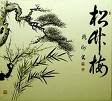 The order of Shochikubai
The order of Shochikubai
(shoochikubai 松竹梅 しょうちくばい ) Sho-Chiku-Bai
Pine (matsu 松 ) ... the most expensive
Bamboo (take 竹) ... medium expensive
Plum (ume 梅 ) ... least expensive (but still expensive ...)
Shochikubai are the three friends of winter in Chinese legend and lore.
saikan sanyu 歳寒三友 "three friends of winter", especially well known during the New Year holidays, when products with their name are auspicious.
. WKD : decoration of pine, bamboo and plum
kigo for the New Year
Rererence Sho Chiku Bai
Sho Chiku Bai Sake from Takara brewery
. . . CLICK here for Photos !
Sho Chiku Bai as anime
. . . CLICK here for Photos !
*****************************
Worldwide use
*****************************
Things found on the way
*****************************
HAIKU
居酒屋の窓に梨咲く薄月夜
izakaya no mado in nashi saku usuzukiyo
at the window of the pub
a nashi pear is in blossom -
night with a hazy moon
居酒屋へいでまゐらせん梅一枝
居酒屋に今年も暮れて面白や
居酒屋に新酒の友を得たりけり
居酒屋の喧嘩押し出す朧月
居酒屋に馬繋ぎけり春の月
居酒屋によらで過ぎ行く燕かな
. Masaoka Shiki 正岡子規 .
.......................................................................
居酒屋に傘を忘るも走り梅雨 岡田成青
居酒屋に席空くを待つ西鶴忌 岸川素粒子
居酒屋に日雇ら足る年忘れ 昌寿
居酒屋に時雨持ちこむ女傘 小池龍渓子
居酒屋に棲む夢千代といふ金魚 山下かず子
居酒屋に棲む廣重とあめふらし 大屋達治 繍鸞
居酒屋に靄たちこむる葱鮪かな 井上唖々
居酒屋のあかりは暗く遠花火 富田巨鹿
居酒屋のいつもの席の凝鮒 沖 鴎潮
居酒屋のさて何処に置く冬帽子 林翔
居酒屋の凭れ柱や衣被 河西みつる
居酒屋の昼定食や荻の風 小澤 實
居酒屋の木の椅子鳴りぬ隙間風 高橋欣也
居酒屋の浅き春なり新メニュー 吉野敏
居酒屋の漢の夕餉初鰊 渡辺とき子
居酒屋の火床にありけり十夜柿 古舘曹人 樹下石上
居酒屋の灯に佇める雪だるま 阿波野青畝
居酒屋の肴となりし年の豆 富本修志
居酒屋の谷中生姜と更けにけり 鈴木鷹夫 風の祭
居酒屋は船員ばかり蚊遣たく 小林清一
source : cgi-bin/HAIKUreikuDB
*****************************
Related words
*****
Michelin and Tokyo Restaurants
Sternenköche
*****
conbini コンビニ / コンビニエンスストア convenience store Combini
*****
WASHOKU : General Information
.....
Hakubutsukan, 食文化博物館 Food Museums and Theme Parks
 bentoo kooyasan kooya san hanya no mizu
See you soon at the local IZAKAYA!
bentoo kooyasan kooya san hanya no mizu
See you soon at the local IZAKAYA!
:::::::::::::::::::::::::::::::::::::::::::::::::::::::::::::::::::::::::::::::::::::::::::::::::::






